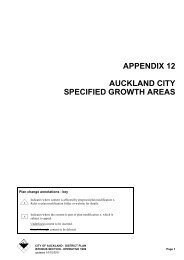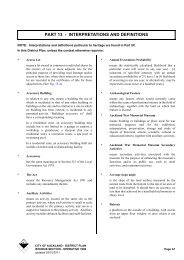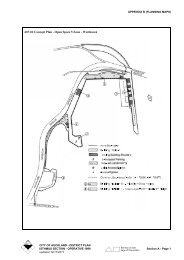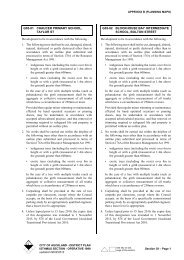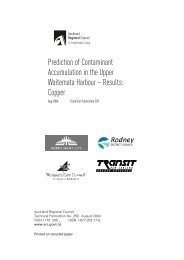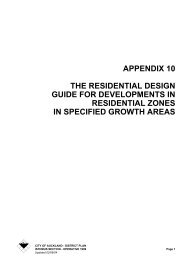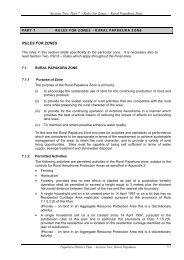North Shore Heritage Thematic Review Report ... - Auckland Council
North Shore Heritage Thematic Review Report ... - Auckland Council
North Shore Heritage Thematic Review Report ... - Auckland Council
Create successful ePaper yourself
Turn your PDF publications into a flip-book with our unique Google optimized e-Paper software.
<strong>Council</strong> erected a plaque on the King Edward Parade foreshore, near Torpedo Bay to commemorate the<br />
arrival of the Tainui canoe.<br />
Typically, the older tribes found themselves in conflict with the newcomers and fortified pa sprang up on<br />
every hill and headland. The Kawarau people generally occupied the north shore of the Waitemata<br />
Harbour and the Ngati Wai the south shore. Other tribes were the Ngati Whatua from <strong>North</strong>land and<br />
Ngati Paoa from Thames. As a result of continual warfare the area became largely depopulated by 1750, and<br />
many pa fell into disrepair. The Takapuna area had become difficult to hold because it was easy to attack<br />
and allowed little chance of retreat or escape due to its island-like shape. After a Ngati Whatua defeat at<br />
Tamaki, the Kawerau chief encouraged Ngati Paoa to refortify <strong>North</strong> Head. They were attacked by Nga<br />
Puhi from <strong>North</strong>land, who besieged the pa for several months during the winter of 1793. The occupants<br />
eventually escaped to Waiheke. Once again the area fell into disrepair, with no permanent population<br />
despite the fertility and natural resources it possessed. After Nga Puhi had withdrawn, Ngati Whatua<br />
controlled the Waitemata. 4<br />
The French explorer, D‟Urville, arrived in 1827 and anchored at Torpedo Bay. This event is commemorated<br />
by a plaque on the foreshore near the Naval Museum. The ship‟s surveyor, Lottin, climbed Mt Victoria –<br />
the first European to do so – and reported on the thick bracken and overgrown weeds. He also commented<br />
on the physical signs of warfare from collapsed fortifications, houses and agricultural fields.<br />
With the end of the musket wars a few Maori returned to settle in Devonport, and were living there when<br />
the Treaty of Waitangi was signed in 1840. Until 1863 a small group of Maori lived near the swamp at<br />
Torpedo Bay, in an area between Cambridge Terrace and Cheltenham Road. The meeting house was on the<br />
second section east of Cambridge Terrace. 5<br />
An early purchase of Devonport land was that of Lot 8, on the northwest side of Mt Victoria, which was<br />
sold to Te Rangi, a former constable in the Armed Police Force. It was sold six years later to a Pakeha and<br />
it is not known if he occupied the land himself. 6<br />
In the 20 th century, it was not until Maori joined the New Zealand Navy in numbers after WWII that any<br />
significant number of Maori lived in Devonport again. The Navy marae, Te Taua Moana, was opened in<br />
2000 and remains the only marae in Devonport.<br />
The famous Nga Puhi chief, Eruera Maihi Patuone, from Hokianga, lived in Devonport and Takapuna in his<br />
later years and is buried in the cemetery at the foot of Mt Victoria. His life spanned from the early<br />
European visits through to the arrival of missionaries, land wars and settlement. With his brother, Tamati<br />
Waka Nene, he was involved in the musket wars, joining up with Hongi Hika. In 1819 they were allied<br />
with Te Rauparaha in a raiding party (taua) that ranged all the way down to Wellington. Later he<br />
recognised the potential of colonisation and the advantages that trade with Europeans would bring. In<br />
1826 and the early 1830s he visited Sydney to arrange for shipments of spars. 7 In 1840 he was baptised by<br />
the Rev. Henry Williams and was an early signatory to the Treaty of Waitangi. On the <strong>North</strong> <strong>Shore</strong> he first<br />
lived on the northern slopes of Mt Victoria and his kainga (compound) was known as Riria, after his late<br />
wife. 8 In 1851 Governor Grey granted him 110 acres between Takapuna Beach and the lagoon by Barry‟s<br />
Point Road. His kainga, Waiwharariki was on the small hill presently occupied by the Assembly of God<br />
church. Eruera Maihi Patuone died in 1872 aged 108. 9 He is remembered in a Devonport street of this name.<br />
4<br />
Devonport Historical & Museum Society.<br />
5<br />
Thomas Walsh, An illustrated story of Devonport and the old <strong>North</strong> <strong>Shore</strong> from 1841 to 1924: with an outline of Maori occupation to<br />
1841, <strong>Auckland</strong>, 1924, 1986 facsimile, p.15.<br />
6<br />
David Verran, The <strong>North</strong> <strong>Shore</strong>: An Illustrated History, <strong>Auckland</strong>, 2010, p.53.<br />
7<br />
Angela Ballara, 'Patuone, Eruera Maihi ?-1872', Dictionary of New Zealand Biography, www.dnzb.govt.nz, updated 22 June<br />
2007.<br />
8 Verran, p.22.<br />
9 Devonport Historical & Museum Society.<br />
<strong>North</strong> <strong>Shore</strong> <strong>Heritage</strong> - <strong>Thematic</strong> <strong>Review</strong> <strong>Report</strong><br />
130






